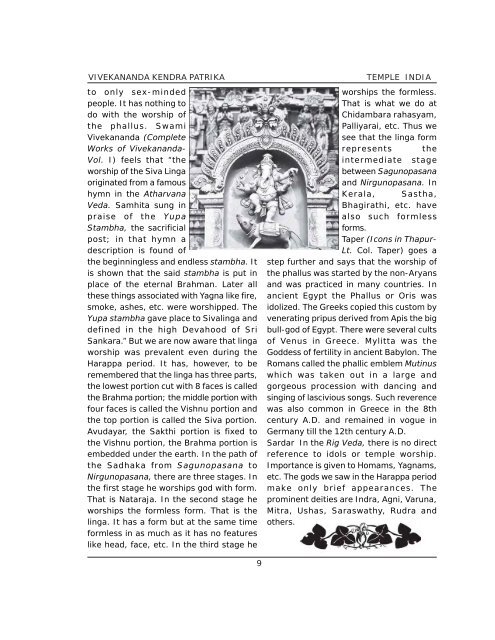Temples In India-1.pdf - Vivekananda Kendra Prakashan
Temples In India-1.pdf - Vivekananda Kendra Prakashan
Temples In India-1.pdf - Vivekananda Kendra Prakashan
You also want an ePaper? Increase the reach of your titles
YUMPU automatically turns print PDFs into web optimized ePapers that Google loves.
VIVEKANANDA KENDRA PATRIKAto only sex-mindedpeople. It has nothing todo with the worship ofthe phallus. Swami<strong>Vivekananda</strong> (CompleteWorks of <strong>Vivekananda</strong>-Vol. I) feels that “theworship of the Siva Lingaoriginated from a famoushymn in the AtharvanaVeda. Samhita sung inpraise of the YupaStambha, the sacrificialpost; in that hymn adescription is found ofthe beginningless and endless stambha. Itis shown that the said stambha is put inplace of the eternal Brahman. Later allthese things associated with Yagna like fire,smoke, ashes, etc. were worshipped. TheYupa stambha gave place to Sivalinga anddefined in the high Devahood of SriSankara.” But we are now aware that lingaworship was prevalent even during theHarappa period. It has, however, to beremembered that the linga has three parts,the lowest portion cut with 8 faces is calledthe Brahma portion; the middle portion withfour faces is called the Vishnu portion andthe top portion is called the Siva portion.Avudayar, the Sakthi portion is fixed tothe Vishnu portion, the Brahma portion isembedded under the earth. <strong>In</strong> the path ofthe Sadhaka from Sagunopasana toNirgunopasana, there are three stages. <strong>In</strong>the first stage he worships god with form.That is Nataraja. <strong>In</strong> the second stage heworships the formless form. That is thelinga. It has a form but at the same timeformless in as much as it has no featureslike head, face, etc. <strong>In</strong> the third stage heTEMPLE INDIAworships the formless.That is what we do atChidambara rahasyam,Palliyarai, etc. Thus wesee that the linga formrepresents theintermediate stagebetween Sagunopasanaand Nirgunopasana. <strong>In</strong>Kerala, Sastha,Bhagirathi, etc. havealso such formlessforms.Taper (Icons in Thapur-Lt. Col. Taper) goes astep further and says that the worship ofthe phallus was started by the non-Aryansand was practiced in many countries. <strong>In</strong>ancient Egypt the Phallus or Oris wasidolized. The Greeks copied this custom byvenerating pripus derived from Apis the bigbull-god of Egypt. There were several cultsof Venus in Greece. Mylitta was theGoddess of fertility in ancient Babylon. TheRomans called the phallic emblem Mutinuswhich was taken out in a large andgorgeous procession with dancing andsinging of lascivious songs. Such reverencewas also common in Greece in the 8thcentury A.D. and remained in vogue inGermany till the 12th century A.D.Sardar <strong>In</strong> the Rig Veda, there is no directreference to idols or temple worship.Importance is given to Homams, Yagnams,etc. The gods we saw in the Harappa periodmake only brief appearances. Theprominent deities are <strong>In</strong>dra, Agni, Varuna,Mitra, Ushas, Saraswathy, Rudra andothers.9
















